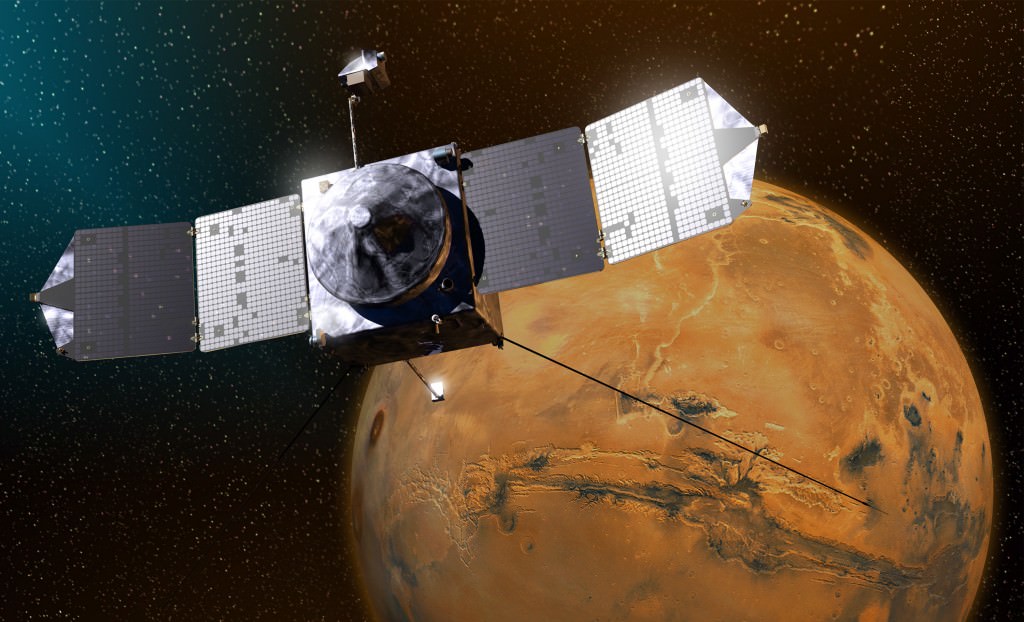Since 2014, NASA’s Mars Atmosphere and Volatile EvolutioN (MAVEN) mission has been orbiting Mars and gathering data on its upper atmosphere, ionosphere, and interactions with the Sun and solar wind. In so doing, the mission has shown how billions of years ago, the Martian atmosphere was slowly stripped away by solar wind. This caused Mars to undergo a major shift in its climate, transforming from a warmer planet that had flowing water on its surface to the extremely frigid and desiccated place it is today.
In February, the mission encountered problems with its main Inertial Measurement Unit (IMU) and entered safe mode. As of Saturday, May 28th, after the mission team successfully diagnosed the issue with these navigation instruments, MAVEN has returned to its normal science and relay operations . Henceforth, the satellite will use a system specially developed by the mission team to navigate by the stars.
This could extend the MAVEN mission’s science operations (which were just extended until 2024) well into the next decade. To determine its orientation in orbit around Mars, MAVEN’s IMUs measure the rate of the spacecraft rotation – IMU-1 is the primary unit while IMU-2 is its backup. On Tuesday, Feb.
22nd, the mission team lost contact with the spacecraft after conducting a routinely-scheduled power cycle of the IMU-1. Once contact was restored, the spacecraft could not determine its attitude from either IMU and switched to its backup computer (which allowed it to obtain accurate readings from IMU-2). Remove All Ads on Universe Today Join our Patreon for as little as $3! Get the ad-free experience for life The spacecraft then entered “safe mode” and waited for further instructions from the ground.
Shannon Curry, MAVEN’s principal investigator at UC Berkeley, said in a recent NASA press release : “This was a critical challenge facing the mission, but thanks to the work of our spacecraft and operations team, MAVEN will continue producing important science and operating as a relay for the surface assets through the end of the decade. I couldn’t be prouder of our team. ” Already, they had been working on an all-stellar navigation mode that would allow MAVEN to navigate without the IMUs.
This is standard practice with aging orbiters that begin to experience equipment issues and was originally meant to be implemented in October 2022 after the mission team detected anomalies in IMU-1 and IMU-2. Switching to an all-stellar navigation mode is standard practice when dealing with aging orbiters and deteriorating navigation units. This incident forced the mission team at Lockheed Martin to expedite the development of the software since the IMU-2 was not predicted to remain in operation until October.
Micheal Haggard, the Lockheed Martin MAVEN spacecraft team lead, explained : “This was a situation that no one initially anticipated, but the spacecraft performed as designed. By the time we ended up on the backup computer, the spacecraft had been attempting to fix the problem with IMU-1 for about 78 minutes. We ended up on IMU-2, and the pressure was on to get the all-stellar mode ready as quickly as possible.
” On April 19th, five months ahead of schedule, the spacecraft team completed the software patch and uplinked it to MAVEN. Since the all-stellar mode had not been previously tested in flight, a series of tests were required to verify the all-stellar mode. The mission team also switched the IMU-2 off to preserve its remaining battery power, just in case it is needed again before the end of the mission.
With the uplink complete, the spacecraft and science teams restored MAVEN’s instruments to their full operation mode. Said Rich Burns, the MAVEN project manager at NASA’s Goddard Space Flight Center: “The team really stepped up to an existential threat. When we recognized in the fall that IMU-2 was degrading, we knew we were going to have to shorten the schedule for all-stellar mode.
The spacecraft team rose to the challenge, working under intense pressure after the anomaly. ” One minor hiccup was the fact that the spacecraft had to be kept pointed at Earth until the mission team concluded testing the all-stellar mode. As a result, MAVEN’s science instruments were not oriented as they would be during regular science operations throughout the shutdown period.
However, this had a very limited effect on the mission, and some science was still possible – such as the coronal mass ejection MAVEN observed hitting Mars’ atmosphere less than two days after the instruments were powered on. MAVEN has continued to operate successfully since using its all-stellar mode, though the mission team will need to find long-term solutions (since there are certain times of year that IMUs must be used). This will ensure that MAVEN can keep operating throughout its extended mission and observe the most extreme conditions in the Martian atmosphere it has so far encountered.
This will continue to provide insight into the process of atmospheric loss that caused Mars to cease being a warmer, wetter, and potentially-habitable planet. The MAVEN mission will continue to function as a communications relay satellite as well, connecting surface missions to Earth via NASA’s Deep Space Network (DSN). Further Reading: NASA.
From: universetoday
URL: https://www.universetoday.com/156276/after-three-months-in-safe-mode-nasas-maven-spacecraft-has-been-recovered/



